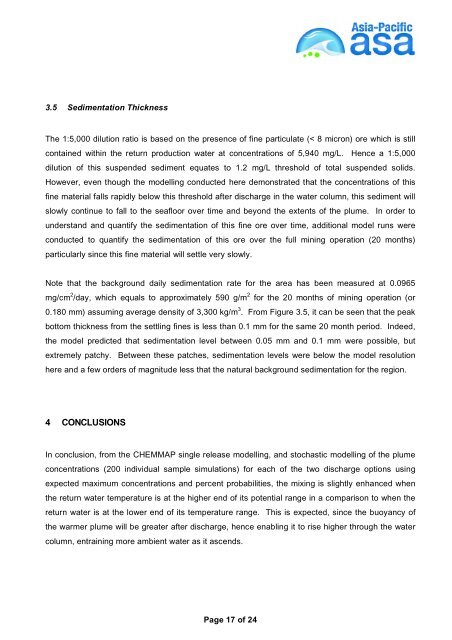Appendices 5-13 - Nautilus Cares - Nautilus Minerals
Appendices 5-13 - Nautilus Cares - Nautilus Minerals
Appendices 5-13 - Nautilus Cares - Nautilus Minerals
Create successful ePaper yourself
Turn your PDF publications into a flip-book with our unique Google optimized e-Paper software.
3.5 Sedimentation Thickness<br />
The 1:5,000 dilution ratio is based on the presence of fine particulate (< 8 micron) ore which is still<br />
contained within the return production water at concentrations of 5,940 mg/L. Hence a 1:5,000<br />
dilution of this suspended sediment equates to 1.2 mg/L threshold of total suspended solids.<br />
However, even though the modelling conducted here demonstrated that the concentrations of this<br />
fine material falls rapidly below this threshold after discharge in the water column, this sediment will<br />
slowly continue to fall to the seafloor over time and beyond the extents of the plume. In order to<br />
understand and quantify the sedimentation of this fine ore over time, additional model runs were<br />
conducted to quantify the sedimentation of this ore over the full mining operation (20 months)<br />
particularly since this fine material will settle very slowly.<br />
Note that the background daily sedimentation rate for the area has been measured at 0.0965<br />
mg/cm 2 /day, which equals to approximately 590 g/m 2 for the 20 months of mining operation (or<br />
0.180 mm) assuming average density of 3,300 kg/m 3 . From Figure 3.5, it can be seen that the peak<br />
bottom thickness from the settling fines is less than 0.1 mm for the same 20 month period. Indeed,<br />
the model predicted that sedimentation level between 0.05 mm and 0.1 mm were possible, but<br />
extremely patchy. Between these patches, sedimentation levels were below the model resolution<br />
here and a few orders of magnitude less that the natural background sedimentation for the region.<br />
4 CONCLUSIONS<br />
In conclusion, from the CHEMMAP single release modelling, and stochastic modelling of the plume<br />
concentrations (200 individual sample simulations) for each of the two discharge options using<br />
expected maximum concentrations and percent probabilities, the mixing is slightly enhanced when<br />
the return water temperature is at the higher end of its potential range in a comparison to when the<br />
return water is at the lower end of its temperature range. This is expected, since the buoyancy of<br />
the warmer plume will be greater after discharge, hence enabling it to rise higher through the water<br />
column, entraining more ambient water as it ascends.<br />
Page 17 of 24


